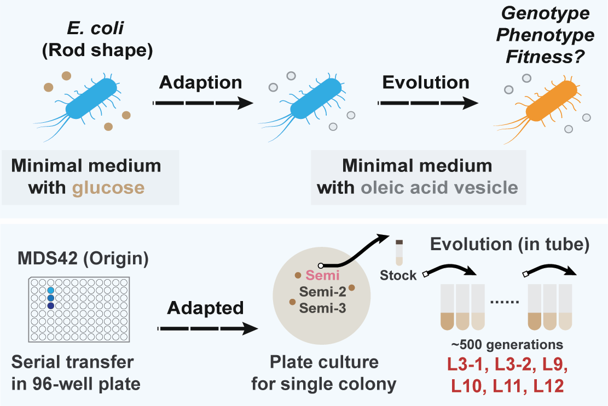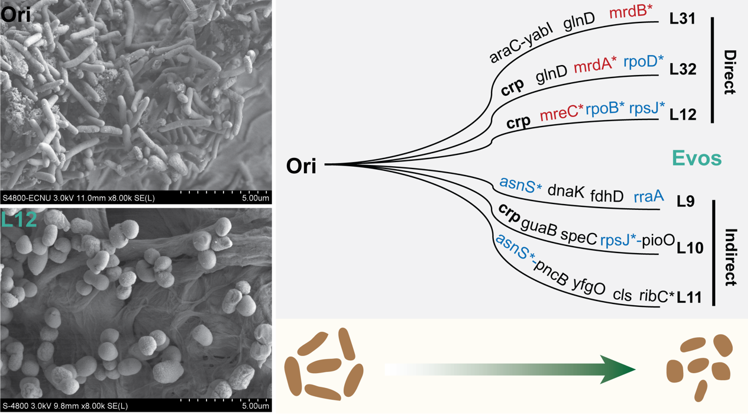


Exploring the shape of primitive cells is crucial to understanding the origin of life, as it globally restricts the physical and chemical features of a cell. Considering the simplicity of the building blocks responsible for primitive cellular life, a spherical structure was assumed and employed in model protocells for decades in studies on the origin of life. However, why a primitive cell may have been spherical and whether spheres were energetically or thermodynamically preferred by primitive cells are still open questions.
Fatty acid vesicles were likely the major components present on the prebiotic Earth and were adopted as the model membranes of protocells. As a representative model of fatty acid vesicles, oleic acid vesicles (OAVs) may be employed as one carbon resource for early life. E. coli is employed as the cell model, as it is the most representative bacterium of the stable rod shape. The morphological change of E. coli from rod to filament when starved of nutrients. Our group asked the following question: What will be the morphological consequence to a modern cell (i.e., E. coli) cultured in a resource utilization regime that mimics a primordial environment. To that end, we designed an experimental evolution of E. coli that employed OAVs as the only carbon source, replacing the commonly used glucose. We investigated whether and how E. coliadapts in an OAV-rich environment. We also assessed how cell morphology changes during experimental evolution under this condition.

Six evolutionary lineages (Evos) were generated under glucose-free but oleic acid vesicle (OAV)-rich conditions. Intriguingly, fitness increase was commonly associated with the morphological change from rod to sphere and the decreases in both the size and the area-to-volume ratio of thecell.Even when we relocated the Evos to a glucose environment, they maintained the spherical shape. The cell morphology was further confirmed by scanning electron microscope (SEM) imaging.

The alteration from rods to spheres of E. coli was associated with many mutations without common mutations, suggesting multiple genetic strategies for morphological changes. Three of the six lineages developed various mutations in the common crp gene. As mutations in crp have been reported in other evolution experiments with glucose, transcriptional regulation by crp might be crucial for E. coli to use carbon sources efficiently.In addition, two distinct adaption strategies to OAV-rich conditions were observed, either directly targeting the cell wall or not. Note that the direct and indirect strategies could be recognized both in the evolutionary dynamics of growth fitness and cell shape and at the morphological level.
The present study provides the first experimental evidence of rod-shaped bacterial cells changing to spherical shapes in a laboratory environment mimicking the resource regime of the primordial environment, in addition to the intensively reported prebiotic demonstrations of primitive cells. If the rod shape was attributed to the evolved cell wall and other cellular structures, the reverse change from rod to spherical form could be considered a breakdown of well-established cellular structures used by modern cells. The wide variety of mutations indicates the wide variety of genetic strategies for the evolution of primitive life.
A spherical primitive cell was speculated for decades, probably because of the physical and thermodynamic stability of spheres. The present study provides a reasonable understanding of the growth benefits of spherical cells in primordial environments, and its findings strongly support this speculation, as did prebiotic studies. The ovoid-shaped protocell (LUCA) and the rod-shaped early bacterium (LBCA) were recently reported. Future studies combining synthetic cells and genetic materials are required to fully clarify the original cell shape.
Read more: https://www.nature.com/articles/s42003-021-02954-w
